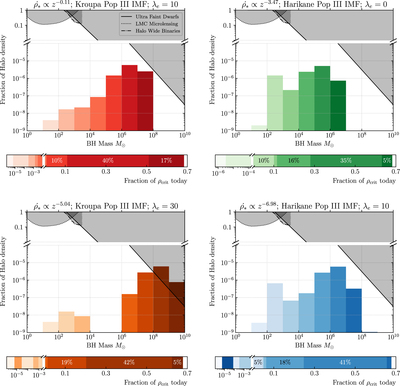Image Details

Caption: Figure 3.
(Vertical bars) Fraction of z = 0 halo density contributed by k = 3 BHs, as produced by the indicated SFRDs in Figure 2. Models are ordered by increasing SFRD power-law slope, with colors set to agree with the model lines in Figure 2. Also displayed (gray, shaded) are current constraints on MACHOs from microlensing (Blaineau et al. 2022), wide halo binary disruption (Monroy-Rodríguez & Allen 2014; Tyler et al. 2022), and ultra-faint dwarf (UFD) galaxy disruption (Brandt 2016). Noting the broken vertical axis, the microlensing and halo binary constraints are easily satisfied. Dwarf galaxy constraints may discriminate candidate SFRD and IMF combinations. As shown, UFD constraints are overly conservative because they do not account for the decrease in comoving BH mass density at earlier times, as will be present in the k > 0 coupled scenario. The effects of accretion at z > 7, as well as adopting a top-heavy IMF (Appendix A), are visible as a decreased fraction in the intermediate-mass BH range. Horizontal bars show the fraction of present-day ΩΛ contributed by each mass bin. Mass bins that contribute <5% of ΩΛ are unlabeled for clarity. Color gradients indicate mass binning and are common to both vertical and horizontal bars. Contributions less than 1%, including negligible contributions omitted in the vertical bars, are also shown in log scaling. Here, contributions are ordered by density fraction.
Copyright and Terms & Conditions
© 2023. The Author(s). Published by the American Astronomical Society.





